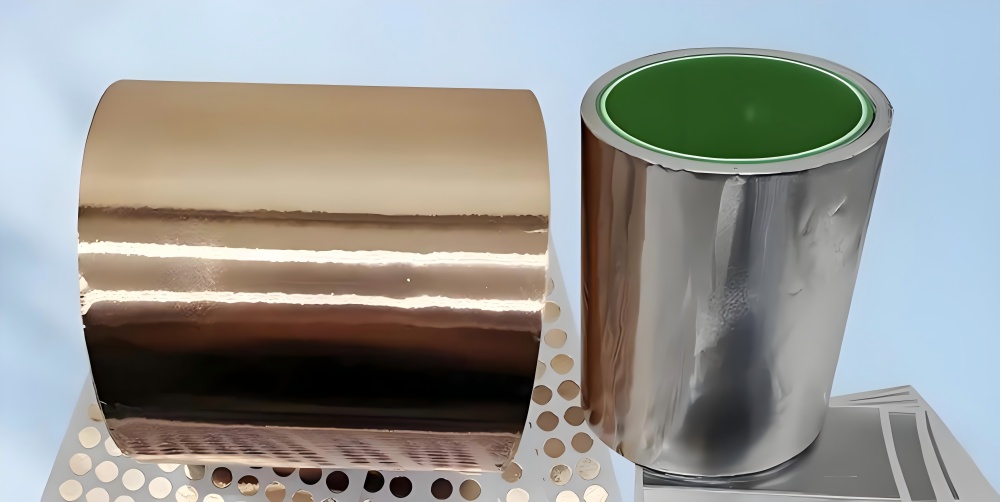Why do lithium-ion batteries use aluminum foil for the positive electrode and copper foil for the negative electrode?
In the core structure of lithium-ion batteries, the use of aluminum foil for the positive electrode and copper foil for the negative electrode is not accidental, but a precise division of labor in material science. For lithium-ion battery manufacturers, this choice directly affects battery performance, safety and cost efficiency. The following is the key scientific logic behind it:
1. Potential adaptability determines material division of labor
The positive electrode of a lithium-ion battery operates at a high potential (3~4 V vs. Li/Li⁺), and a nano-scale aluminum oxide (Al₂O₃) insulating layer will naturally form on the surface of the aluminum foil. This "quantum tunneling film" can both conduct electrons and prevent high-voltage corrosion - this is the key to aluminum foil becoming an irreplaceable positive electrode current collector. On the other hand, the negative electrode: copper foil is stable and does not alloy at a low potential (0.1~0.2 V), while aluminum foil will combine with lithium in this environment to form LiAl alloy, causing structural collapse. Therefore, each lithium-ion battery negative electrode must rely on the chemical inertness of copper foil.
2. Material stability drives design differences
When lithium-ion batteries are over-discharged, aluminum foil will corrode catastrophically in the low potential area. Copper foil is easily oxidized if exposed to high potential (>3.5 V), but this risk is avoided thanks to the natural low-voltage environment of the negative electrode. This is why high-voltage systems such as lithium iron phosphate batteries (LiFePO4 battery) have extremely high requirements for the purity of positive electrode aluminum foil - the lithium iron phosphate battery manufacturer must ensure that the pressure-resistant thickness error of the aluminum current collector does not exceed 1μm.
3. A precise balance between manufacturing process and performance
(1) Ductility advantage: Copper foil can be rolled to 6μm (close to 1/10 of the diameter of a hair), which greatly reduces the weight of lithium-ion batteries;
(2) Mechanical strength: Aluminum foil has higher tensile strength and is suitable for positive electrode slurry coating process;
(3) Interface compatibility: Aluminum foil has strong adhesion with positive electrode materials such as lithium cobalt oxide and lithium iron phosphate, while copper foil has better wettability with graphite negative electrode.
For LiFePO4 battery manufacturers, the current collector selection directly affects the electrode interface impedance, which in turn determines the battery cycle life.
(2) Mechanical strength: Aluminum foil has higher tensile strength and is suitable for positive electrode slurry coating process;
(3) Interface compatibility: Aluminum foil has strong adhesion with positive electrode materials such as lithium cobalt oxide and lithium iron phosphate, while copper foil has better wettability with graphite negative electrode.
For LiFePO4 battery manufacturers, the current collector selection directly affects the electrode interface impedance, which in turn determines the battery cycle life.
4. The game between cost and thermal management
The density of aluminum (2.7 g/cm³) is only 30% of that of copper, making it possible to make lithium-ion batteries lightweight; at the same time, the cost of aluminum raw materials is significantly reduced. In terms of thermal stability: copper foil has better thermal conductivity (conducive to the heat dissipation of the negative electrode), but the high temperature oxidation resistance of aluminum foil is perfectly matched to the working environment of the positive electrode.
From lithium iron phosphate battery to ternary lithium battery, the combination of positive aluminum foil and negative copper foil is a win-win choice for electrochemistry and material mechanics. Professional lithium iron phosphate battery manufacturer ensures that each lithium-ion battery achieves the optimal solution between safety, energy density and cost by precisely controlling the current collector purity, thickness and surface treatment process (such as cathode electrophoresis). This "art of metal division of labor" will continue to drive the evolution of lithium-ion battery technology towards a more efficient and reliable direction.
From lithium iron phosphate battery to ternary lithium battery, the combination of positive aluminum foil and negative copper foil is a win-win choice for electrochemistry and material mechanics. Professional lithium iron phosphate battery manufacturer ensures that each lithium-ion battery achieves the optimal solution between safety, energy density and cost by precisely controlling the current collector purity, thickness and surface treatment process (such as cathode electrophoresis). This "art of metal division of labor" will continue to drive the evolution of lithium-ion battery technology towards a more efficient and reliable direction.
 +86 13332949210
+86 13332949210 info@xihobattery.com
info@xihobattery.com







 Xiho
Xiho Jun 24 2025
Jun 24 2025











